NCERT Exemplar Class 9 Maths Chapter 2 Polynomials are part of NCERT Exemplar Class 9 Maths. Here we have given NCERT Exemplar Class 9 Maths Solutions Chapter 2 Polynomials.
NCERT Exemplar Class 9 Maths Solutions Chapter 2 Polynomials
Exercise 2.1
Question 1.
Which one of the following is a polynomial?

Solution:
(C)
![]()
It is not a polynomial, because one of the exponents of x is – 2, which is not a whole number.
![]()
It is not a polynomial, because exponent of x is 1/2 which is not a whole number.

It is a polynomial, because each exponent of x is a whole number.
![]()
It is not a polynomial because it is a rational function.
Question 2.
√2 is a polynomial of degree
(a) 2
(b) 0
(c) 1
(d)½
Solution:
(b) √2 = -√2x°. Hence, √2 is a polynomial of degree 0, because exponent of x is 0.
Question 3.
Degree of the polynomial 4x4 + 0x3 + 0x5 + 5x + 7 is
(a) 4
(b) 5
(c) 3
(d) 7
Solution:
(a) 4
4x4 + 0x3 + 0x5 + 5x + 7 = 4x4 + 5x + 7
As we know that the degree of a polynomial is equal to the highest power of variable x.
Here, the highest power of x is 4. Therefore, the degree of the given polynomial is 4.
Question 4.
Degree of the zero polynomial is
(A) 0
(B) 1
(C) Any natural number
(D) Not defined
Solution:
(D): In zero polynomial, the coefficient of any power of variable is zero i.e., 0x², 0x5 etc.
Therefore, we can not exactly determine the highest power of variable, hence cannot define the degree of zero polynomial.
Question 5.
If p (x) = x2 – 2√2x + 1, then p (2√2) is equal to
(a) 0
(b) 1
(c) 4√2
(d) 8 √2 +1
Solution:
(b) Given, p(x) = x2 – 2√2x + 1 …(i)
On putting x = 2√2 in Eq. (i), we get
P(2√2) = (2√2)2– (2√2)(2√2) + 1 = 8 – 8 + 1 = 1
Question 6.
The value of the polynomial 5x – 4x2 + 3, when x = – 1 is
(a)-6
(b) 6
(c) 2
(d) -2
Solution:
(a) Let p (x) = 5x – 4x2 + 3 …(i)
On putting x = -1 in Eq. (i), we get
p(-1) = 5(-1) -4(-1)2 + 3= -5 – 4 + 3 = -6
Question 7.
If p (x) = x + 3, then p(x) + p(- x) is equal to
(a) 3
(b) 2x
(c) 0
(d) 6
Solution:
(d) Given p(x) = x + 3, put x = -x in the given equation, we get p(-x) = -x + 3
Now, p(x) + p(-x) = x + 3 + (-x) + 3 = 6
Question 8.
Zero of the zero polynomial is
(a) 0
(b) 1
(c) any real number
(d) not defined
Solution:
(c) Zero of the zero polynomial is any real number.
e.g., Let us consider zero polynomial be 0(x – k), where k is a real number For determining the zero, put x – k = 0 ⇒ x = k
Hence, zero of the zero polynomial be any real number.
Question 9.
Zero of the polynomial p(x) = 2x + 5 is
(a) -2/5
(b) -5/2
(c) 2/5
(d) 5/2
Solution:
(b) Given, p(x) = 2x + 5
For zero of the polynomial, put p(x) = 0
∴ 2x + 5 = 0
⇒ -5/2
Hence, zero of the polynomial p(x) is -5/2.
Question 10.
One of the zeroes of the polynomial 2x2 + 7x – 4 is
(a) 2
(b) ½
(c) -1
(d) -2
Solution:
(b) Let p (x) = 2x2 + 7x – 4
= 2x2 + 8x – x – 4 [by splitting middle term]
= 2x(x+ 4)-1(x + 4)
= (2x-1)(x+ 4)
For zeroes of p(x), put p(x) = 0
⇒ (2x -1) (x + 4) = 0
⇒ 2x – 1 = 0 and x + 4 = 0
⇒ x = ½ and x = -4
Hence, one of the zeroes of the polynomial p(x) is ½.
Question 11.
If x51 + 51 is divided by x + 1, then the remainder is
(a) 0
(b) 1
(c) 49
(d) 50
Solution:
(d) Let p(x) = x51 + 51 . …(i)
When we divide p(x) by x+1, we get the remainder p(-1)
On putting x = -1 in Eq. (i), we get p(-1) = (-1)51 + 51
= -1 + 51 = 50
Hence, the remainder is 50.
Question 12.
If x + 1 is a factor of the polynomial 2x2 + kx, then the value of k is
(a) -3
(b) 4
(c) 2
(d)-2
Solution:
(c) Let p(x) = 2x2 + kx
Since, (x + 1) is a factor of p(x), then
p(-1)=0
2(-1)2 + k(-1) = 0
⇒ 2 – k = 0
⇒ k = 2
Hence, the value of k is 2.
Question 13.
x + 1 is a factor of the polynomial
(a) x3 + x2 – x + 1
(b) x3 + x2 + x + 1
(c) x4 + x3 + x2 + 1
(d) x4 + 3x3 + 3x2 + x + 1
Solution:
(b) Let assume (x + 1) is a factor of x3 + x2 + x + 1.
So, x = -1 is zero of x3 + x2 + x + 1
(-1)3 + (-1)2 + (-1) + 1 = 0
⇒ -1 + 1 – 1 + 1 = 0
⇒ 0 = 0 Hence, our assumption is true.
Question 14.
One of the factors of (25x2 – 1) + (1 + 5x)2 is
(a) 5 + x
(b) 5 – x
(c) 5x -1
(d) 10x
Solution:
(d) Now, (25x2 -1) + (1 + 5x)2
= 25x2 -1 + 1 + 25x2 + 10x [using identity, (a + b)2 = a2 + b2 + 2ab]
= 50x2 + 10x = 10x (5x + 1)
Hence, one of the factor of given polynomial is 10x.
Question 15.
The value of 2492 – 2482 is
(a) 12
(b) 477
(c) 487
(d) 497
Solution:
(d) Now, 2492 – 2482 = (249 + 248) (249 – 248) [using identity, a2 – b2 = (a – b)(a + b)]
= 497 × 1 = 497.
Question 16.
The factorization of 4x2 + 8x+ 3 is
(a) (x + 1) (x + 3)
(b) (2x + 1) (2x + 3)
(c) (2x + 2) (2x + 5)
(d) (2x – 1) (2x – 3)
Solution:
(b) Now, 4x2 + 8x + 3= 4x2 + 6x + 2x + 3 [by splitting middle term]
= 2x(2x + 3) + 1 (2x + 3)
= (2x + 3) (2x + 1)
Question 17.
Which of the following is a factor of (x+ y)3 – (x3 + y3)?
(a) x2 + y2 + 2 xy
(b) x2 + y2 – xy
(c) xy2
(d) 3xy
Solution:
(d) Now, (x+ y)3 – (x3 + y3) = (x + y) – (x + y)(x2– xy + y2)
[using identity, a3 + b3 = (a + b)(a2 – ab + b2)] = (x + y)[(x + y)2 -(x2 – xy + y2)]
= (x+ y)(x2+ y2+ 2xy – x2+ xy – y2)
[using identity, (a + b)2 = a2 + b2 + 2 ab)]
= (x + y) (3xy)
Hence, one of the factor of given polynomial is 3xy.
Question 18.
The coefficient of x in the expansion of (x + 3)3 is
(a) 1
(b) 9
(c) 18
(d) 27
Solution:
(d) Now, (x + 3)3 = x3 + 33 + 3x (3)(x + 3)
[using identity, (a + b)3 = a3 + b3 + 3ab (a + b)]
= x3 + 27 + 9x (x + 3)
= x3 + 27 + 9x2 + 27x Hence, the coefficient of x in (x + 3)3 is 27.
Question 19.
![]()
(a) 1
(b) -1
(c) 0
(d) 1/2
Solution:
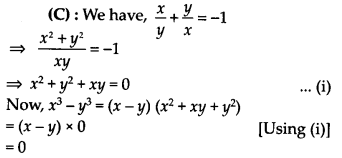
Question 20.
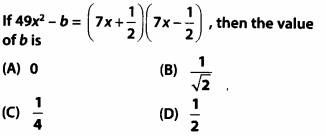
Solution:
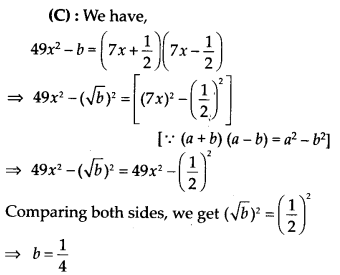
Question 21.
If a + b + c =0, then a3 + b3 + c3 is equal to
(a) 0
(b) abc
(c) 3abc
(d) 2abc
Solution:
(d) Now, a3 + b3 + c3 = (a + b + c) (a2 + b2 + c2 – ab – be – ca) + 3abc
[using identity, a3 + b3 + c3 – 3 abc = (a + b + c)(a2 + b2 + c2 – ab – be – ca)]
= 0 + 3abc [∴ a + b + c = 0, given]
a3 + b3 + c3 = 3abc
Exercise 2.2
Question 1.
Which of the following expressions are polynomials? Justify your answer:
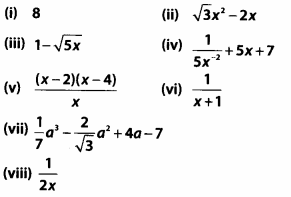
Solution:
(i) Polynomial
Because 8 = 8x°, then exponent of the variable x is 0, which is a whole number.
(ii) Polynomial
Each exponent of the variable x is a whole number.
(iii) Not polynomial
Because exponent of the variable x is 1/2, which is not a whole number.
(iv) Polynomial
Because each exponent of the variable x is a whole number.
(v) Not polynomial
Because one of the exponents of the variable x is -1, which is not a whole number.
(vi) Not polynomial
Because given expression is a rational expression, thus, not a polynomial.
(vii) Polynomial
Because each exponent of the variable a is a whole number.
(viii) Not polynomial

Question 2.
Write whether the following statements are True or False. Justify your answer.
(i) A binomial can have atmost two terms
(ii) Every polynomial is a binomial
(iii) A binomial may have degree 5
(iv) Zero of a polynomial is always 0
(v) A polynomial cannot have more than one zero
(vi) The degree of the sum of two polynomials each of degree 5 is always 5.
Solution:
(i) False
Because a binomial has exactly two terms.
(ii) False
Because every polynomial is not a binomial.
e.g., (a)x² + 4x + 3 [polynomial but not a binomial]
(b) x² + 5 [polynomial and also a binomial]
(iii) True
Because a binomial is a polynomial whose degree is a whole number which is greater than or equal to one. Therefore, a binomial may have degree 5.
(iv) False
Because zero of a polynomial can be any real number e.g., for p(x) = x – 1, zero of p(x) is 1, which is a real number.
(v) False
Because a polynomial can have any number of zeroes. It depends upon the degree of the polynomial. e.g. for p(x) = x² – 4, degree is 2, so it has two zeroes i.e., 2 and -2.
(vi) False
Because the sum of any two polynomials of same degree has not always same degree.
e.g., Let f(x) = x5 + 2 and g(x) = -x5 + 2x2
∴ Sum of two polynomials, f(x) + g(x) = x5 + 2 + (-x5 + 2x2) = 2x2 + 2, which is not a polynomial of degree 5.
Exercise 2.3
Question 1.
Classify the following polynomials as polynomials in one variable, two variables etc.
(i) x2 + x + 1
(ii) y3 – 5y
(iii) xy + yz + zx
(iv) x2 – Zxy + y2 + 1
Solution:
(i) Polynomial x2 + x + 1 is a one variable polynomial, because it contains only one variable i.e., x.
(ii) Polynomial y3 – 5y is a one variable polynomial, because it contains only one variable i.e., y.
(iii) Polynomial xy + yz + zx is a three variables polynomial, because it contains three variables x, y and z.
(iv) Polynomial x2 – 2xy + y2 + 1 is a two variables polynomial, because it contains two variables x and y.
Question 2.
Determine the degree of each of the following polynomials.
(i) 2x – 1
(ii) -10
(iii) x3 – 9x + 3x5
(iv) y3(1 – y4)
Solution:
(i) Degree of polynomial 2x – 1 is 1, Because the maximum exponent of x is 1.
(ii) Degree of polynomial – 10 or – 10x° is 0, because the exponent of x is 0.
(iii) Degree of polynomial x3 – 9x + 3x5 is 5, because the maximum exponent of x is 5.
(iv) Degree of polynomial y3(1 – y4) or y3 – y7 is 7, because the maximum exponent of y is 7.
Question 3.
![]()
(i) the degree of the polynomial
(ii) the coefficient of x3
(iii) the coefficient of x6
(iv) the constant term
Solution:
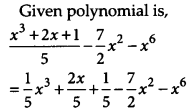
(i) The degree of the polynomial is the highest power of the variable x i.e., 6.
(ii) The coefficient of x3 in given polynomial is 1/5
(iii) The coefficient of x6 in given polynomial is -1.
(iv) The constant term in given polynomial is 1/5
Question 4.
Write the coefficient of x² in each of the following

Solution:
![]()
(ii) Coefficient of x2 in 3x – 5 is 0.
(iii) We have, (x – 1) (3x – 4) = 3x2 – 7x + 4
∴ Coefficient of x² in 3x² – 7x + 4 is 3.
(iv) We have, (2x – 5) (2x² – 3x + 1)
= 2x (2x² – 3x + 1) – 5(2x² – 3x + 1)
= 4x³ – 6x² + 2x – 10x² + 15x – 5
= 4x³ – 16x² + 17x – 5
Coefficient of x² in 4x³ – 16x² + 17x – 5 is -16.
Question 5.
Classify the following as constant, linear, quadratic and cubic polynomials:
(i) 2 – x² + x³
(ii) 3x³
(iii) 5t – √7
(iv) 4 – 5y²
(v) 3
(vi) 2 + x
(vii) y³ – y
(viii) 1 + x + x²
(ix) t²
(x) √2x – 1
Solution:
(i) Polynomial 2 – x² + x³ is a cubic polynomial, because its degree is 3.
(ii) Polynomial 3x³ is a cubic polynomial, because its degree is 3.
(iii) Polynomial 5t – √7 is a linear polynomial, because its degree is 1.
(iv) Polynomial 4 – 5y² is a quadratic polynomial, because its degree is 2.
(v) Polynomial 3 = 3x° is a constant polynomial, because its degree is 0.
(vi) Polynomial 2 + x is a linear polynomial, because its degree is 1.
(vii) Polynomial y³ – y is a cubic polynomial, because its degree is 3.
(viii) Polynomial 1 + x + x² is a quadratic polynomial, because its degree is 2.
(ix) Polynomial t² is a quadratic polynomial, because its degree is 2.
(x) Polynomial √2x – 1 is a linear polynomial, because its degree is 1.
Question 6.
Give an example of a polynomial, which is
(i) monomial of degree 1.
(ii) binomial of degree 20.
(iii) trinomial of degree 2.
Solution:
(i) The example of monomial of degree 1 is 3x.
(ii) The example of binomial of degree 20 is 3x20 + x10
(iii) The example of trinomial of degree 2 is x2 – 4x + 3
Question 7.
Find the value of the polynomial 3x3 – 4x2 + 7x – 5, when x = 3 and also when x = -3.
Solution:
Let p(x) =3x3 – 4x2 + 7x – 5
At x= 3, p(3) = 3(3)3 – 4(3)2 + 7(3) – 5
= 81 – 36 + 21 – 5
∴ P( 3) = 61
At x = -3, p(-3)= 3(-3)3 – 4(-3)2 + 7(-3) – 5
= -81 – 36 – 21 – 5 = -143
∴ p(-3) = -143
Hence, the value of the given polynomial at x = 3 and x = -3 are 61 and -143, respectively.
Question 8.
If p (x) = x2 – 4x + 3, then evaluate p(2) – p (-1) + p ( ½).
Solution:
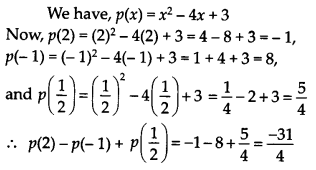
Question 9.
Find p(0), p( 1) and p(-2) for the following polynomials
(i) p(x) = 10x – 4x2 – 3
(ii) p(y) = (y + 2)(y – 2)
Solution:
(i) Given, polynomial is
p(x) = 10x – 4x2 – 3
On putting x = 0, 1 and – 2, respectively in Eq. (i),
we get p(0) = 10(0) – 4(0)2 – 3 = 0 – 0 – 3 = -3
p(1) = 10 (1) – 4 (1 )2 – 3
= 10 – 4 – 3= 10 – 7 = 3
and p(-2) =10 (-2) -4 (-2)2 – 3
= -20- 4 × 4 – 3 = -20 – 16 – 3 = -39
Hence, the values of p(0), p(1) and p(-2) are respectively, -3, 3 and – 39.
(ii) Given, polynomial isp(y) = (y+2)(y-2)
On putting y =0,1 and -2, respectively in Eq. (i), we get p(0) = (0+2)(0-2) = -4
p(1) = (1 + 2)(1-2)
= 3 x (-1) = -3
and p(-2) = (-2 + 2)(-2 -2)
= 0 (-4) = 0
Hence, the values of p(0), p(1) and p(-2) are respectively, -4, -3 and 0.
Question 10.
Verify whether the following are true or false.
(i) -3 is a zero of at – 3
(ii) -1/3 is a zero of 3x + 1
(iii) -4/5 is a zero of 4 – 5y
(iv) 0 and 2 are the zeroes of t2 – 2t
(v) -3 is a zero of y2 + y – 6
Solution:
(i) False
Put x – 3 = 0 ⇒ x = 3
Hence, zero of x – 3 is 3.
(ii) True
Put 3x + 1 = 0 ⇒ x = -1/3
Hence, zero of 3x + 1 is -1/5.
(iii) False
Put 4 – 5y = 0 ⇒ y = 4/5
Hence, zero of 4 – 5y is 4/5.
(iv) True
Put t² – 2t = 0 ⇒ t(t – 2) = 0
⇒ t = 0 and t – 2 = 0
⇒ t = 0 and t = 2
Hence, the zeroes of t² – 2t are 0 and 2.
(v) True
Put y² + y – 6 = 0 ⇒ y² + 3y – 2y – 6 = 0
⇒ y(y + 3) – 2(y + 3) = 0
= (y-2)(y + 3) = 0
⇒ y – 2 = 0 and y + 3 = 0
⇒ y = 2 and y = -3
Hence, the zeroes of y² + y – 6 are 2 and – 3.
Question 11.
Find the zeroes of the polynomial in each of the following,
(i) p(x)= x – 4
(ii) g(x)= 3 – 6x
(iii) q(x) = 2x – 7
(iv) h(y) = 2y
Solution:
(i) Given, polynomial is
p(x) = x – 4
For zero of polynomial, put p(x) = 0
∴ x – 4 = 0 ⇒ x = 4
Hence, zero of polynomial is 4.
(ii) Given, polynomial is
g(x) = 3 – 6x
For zero of polynomial, put g(x) = 0
∴ 3 – 6x = 0 ⇒ x = 3/6 = 1/2.
Hence, zero of polynomial is X
(iii) Given, polynomial is q(x) = 2x – 7 For zero of polynomial, put q(x) = 0
∴ 2x – 7 = 0 ⇒ 2x = 7 ⇒ x = 7/2
Hence, zero of polynomial q(x) is 7/2
(iv) Given polynomial h(y) = 2 y
For zero of polynomial, put h(y) = 0
∴ 2y = 0 ⇒ y = 0
Hence, the zero of polynomial h(y) is 0.
Question 12.
Find the zeroes of the polynomial p(x) = (x – 2)2 – (x + 2)2.
Solution:
Given, polynomial is p(x) = (x – 2)2 – (x + 2)2
For zeroes of polynomial, put p(x) = 0
∴ (x – 2)2 – (x + 2)2 = 0
⇒ (x – 2 + x + 2)(x – 2 – x – 2) = 0
[using identity, a2 – b2 = (a – b)(a + b)]
⇒ (2x)(-4) = 0
⇒ -8x = 0
⇒ x = 0
Therefore zero of the polynomial is p(x) is 0.
Question 13.
By actual division, find the quotient and the remainder when the first
polynomial is divided by the second polynomial x4 + 1 and x – 1.
Solution:
Using long division method
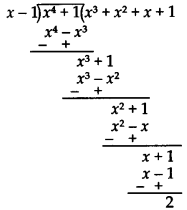
Hence, quotient = x³ + x² + x + 1 and remainder = 2
Question 14.
By remainder theorem, find the remainder when p(x) is divided by g(x)
(i) p(x) = x3 – 2x2 – 4x – 1, g(x) = x + 1
(ii) p(x) = x3 – 3x2 + 4x + 50, g(x) = x – 3
(iii) p(x) = x3 – 12x2 + 14x – 3, g(x) = 2x – 1 – 1
(iv) p(x) = x3 – 6x2 + 2x – 4, g(x) = 1 – (3/2) x
Solution:
(i) We have, p(x) = x³ – 2x² – 4x – 1 and g(x) = x + 1
Here, zero of g(x) is -1.
When we divide p(x) by g(x) using remainder theorem, we get the remainder p(-1)
∴ p(-1) = (-1)³ – 2(-1)² – 4(-1) -1
= -1 – 2 + 4 – 1 = 0
Therefore, remainder is 0.
(ii) We have, p(x) = x³ – 3x² + 4x + 50 and g(x) = x – 3
Here, zero of g(x) is 3.
When we divide p(x) by g(x) using remainder theorem, we get the remainder p(3)
∴ p(3) = (3)³ – 3(3)² + 4(3) + 50
= 27 – 27 + 12 + 50 = 62
Therefore, remainder is 62.
(iii) We have, p(x) = 4x³ – 12x² + 14x – 3 and g(x) = 2x -1
Here, zero of g(x) is 1/2
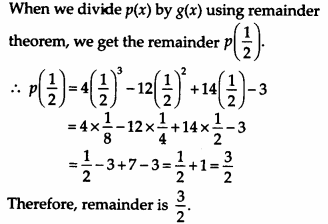
Question 15.
Check whether p(x) is a multiple of g(x) or not
(i) p(x) = x3 – 5x2 + 4x – 3, g(x) = x – 2.
(ii) p(x) = 2x3 – 11x2 – 4x + 5, g(x) = 2x + 1
Solution:
(i) We have, g(x) = x – 2
Here, zero of g(x) is 2.
Now, p(x) = x3 – 5x2 + 4x – 3
∴ p(2) = (2)3 – 5(2)2 + 4(2) – 3
= 8 – 20 + 8 – 3 = – 7
Since, remainder ≠ 0, then p(x) is not a multiple of g(x).
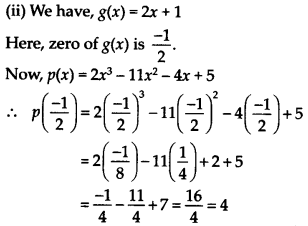
Since, remainder ≠ 0, then p(x) is not a multiple of g(x).
Question 16.
Show that,
(i) x + 3 is a factor of 69 + 11x – x2 + x3
(ii) 2x – 3 is a factor of x + 2x3 -9x2 +12
Solution:
(i) Let p(x) = x3 – x2 + 11x + 69
x + 3 is a factor of p(x) if p(-3) = 0
Now, p(-3) = (-3)3 – (-3)2 + 11(-3) + 69
= – 27 – 9 – 33 + 69 = 0
Therefore, (x + 3) is a factor of p(x).
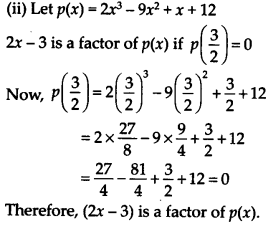
Question 17.
Determine which of the following polynomial has x – 2 a factor
(i) 3x2 + 6x – 24
(ii) 4x2+ x – 2
Solution:
(i) Let p(x) = 3x2 + 6x – 24 … (1)
Substituting x = 2 in (1), we get
p(2) = 3(2)2 + 6(2) – 24
= 12 + 12 – 24 = 0
Hence, x – 2 is a factor of p(x).
(ii)Let p(x) = 4x2 + x – 2 … (2)
Substituting x = 2 in (2), we get
p(2) = 4(2)2 + 2 – 2 = 16 ≠ 0
Hence, x – 2 is not a factor of p(x).
Question 18.
Show that p-1 is a factor of p10 -1 and also of p11 -1.
Solution:
Let g (p) = p10 -1 …(1)
and h(p) = p11 -1 …(2)
On putting p = 1 in Eq. (i), we get
g(1) = 110 -1 = 1 – 1 = 0
Hence, p-1 is a factor of g(p).
Again, putting p = 1 in Eq. (2), we get
h (1) = (1)11 -1 = 1 – 1 = 0
Hence, p -1 is a factor of h(p).
Question 19.
For what value of m is x3 -2mx2 +16 divisible by x + 2?
Solution:
Let p(x) = x3 – 2mx2 + 16
Since, p(x) is divisible by (x+2), then remainder = 0
P(-2) = 0
⇒ (-2)3 – 2m(-2)2 + 16 = 0
⇒ -8 – 8m + 16 = 0
⇒ 8m = 8
m = 1
Hence, the value of m is 1.
Question 20.
If x + 2a is a factor of a5 – 4a2x3 + 2x + 2a + 3, then find the value of a.
Solution:
Let p(x) =a5 – 4a2x3 + 2x + 2a + 3
Since, x + 2a is a factor of p(x), then put p(-2a) = 0
∴ (-2a)5 – 4a2 (-2a)3 + 2(-2a) + 2a + 3 = 0
⇒ -32a5 + 32a5 – 4a + 2a + 3 = 0
⇒ -2a + 3 = 0
2a = 3
a = 3/2.
Hence, the value of a is 3/2.
Question 21.
Find the value of m, so that 2x -1 be a factor of
8x4 + 4x3 – 16x2 + 10x + m
Solution:
Let p(x) = 8x4 + 4x3 – 16x2 + 10x + m
Since 2x – 1 is afactor of p(x) then p(1/2) = 0
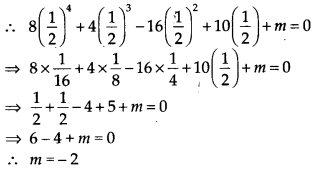
Question 22.
If x + 1 is a factor of ax3 + x2 – 2x + 4o – 9, find the value of a.
Solution:
Let p(x) = ax3 + x2 – 2x + 4a – 9
Since, x + 1 is a factor of p(x), then p(-1) = 0
a(- 1)3+ (- 1)2 – 2(-1) + 4a – 9 = 0
⇒ -a + 1 + 2 + 4a – 9 = 0
⇒ 3a = 6
⇒ a = 2
Question 23.
Factorise:
(i) x2 + 9x + 18
(ii) 6x2 + 7x – 3
(iii) 2x2– 7x – 15
(iv) 84 – 2r – 2r2
Solution:
(i) We have, x2 + 9x +18 = x2 + 6x + 3x +18
= x(x + 6) + 3(x + 6) = (x + 3) (x + 6)
We have, 6x2 + 7x – 3 = 6x2 + 9x – 2x – 3
= 3x(2x + 3) – 1(2x + 3) = (3x – 1)(2x + 3)
We have, 2x2 – 7x – 15 = 2x2 – 10x + 3x -15
= 2x(x – 5) + 3(x – 5) = (2x + 3)(x – 5)
We have, 84 – 2r – 2r2 = – 2 (r2 + r – 42)
= -2(r2 + 7r – 6r – 42)
= -2[r(r + 7) -6(r + 7)]
= 2(6 – r)(r + 7) or 2(6 – r) (7 + r)
Question 24.
Factorise:
(i) 2x3 – 3x2 – 17x + 30
(ii) x3-6x2+11x-6
(iii) x3 + x2-4x-4
(iv) 3x3-x2-3x+1
Solution:
(i) We have, 2X3 – 3x2 – 17x + 30
= 2x3 – 4x2 + x2 – 2x – 15x + 30
= 2x2(x – 2) + x(x – 2) – 15(x – 2)
= (x – 2) (2x2 + x – 15)
= (x – 2) (2x2 + 6x – 5x – 15)
= (x – 2) [2x(x + 3) – 5(x + 3)]
= (x – 2)(x + 3)(2x – 5)
(ii)We have, x3 – 6x2 + 11x – 6
= x3 – x2 – 5x2 + 5x + 6x – 6
= x2(x – 1) – 5x (x – 1) + 6(x – 1)
= (x -1) (x2 – 5x + 6)
= (x – 1) (x2 – 3x – 2x + 6)
= (x – 1) [x(x – 3) – 2(x – 3)]
= (x-1)(x-2)(x-3)
(iii) We have, x3 + x2 – 4x – 4
= x2(x + 1) – 4(x + 1)
= (x + 1)(x2 – 4)
= (x + 1) (x – 2) (x + 2)[∴ a2– b2 = (a – b) (a + b)]
(iv) We have, 3x3 – x2 – 3x + 1 = 3x3 – 3x2 + 2x2– 2x – x + 1
= 3x2 (x – 1) + 2x(x – 1) -1(x – 1)
= (x – 1)(3x2 + 2x – 1)
= (x – 1) (3x2 + 3x – x – 1)
= (x – 1) [3x(x + 1) – 1(x + 1)]
= (x – 1) (x + 1)(3x -1)
Question 25.
Using suitable identity, evaluate the following:
(i) 1033
(ii) 101 × 102
(iii) 9992
Solution:
(i) We have, 1033 = (100 + 3)3
= (100)3 + (3)3 + 3(100)(3)(100 + 3)
[∴ (a + b)3 = a3 + b3 + 3ab(a + b)]
= 1000000 + 27 + 900(103)
= 1000027 + 92700 = 1092727
(ii) We have, 101 × 102 = (100 + 1) (100 + 2)
= (100)2 + (1 + 2)100 + (1)(2)
[∴ (x + a)(x + b) = x2 + (a + b)x + ab]
= 10000 + 300 + 2 = 10302
(iii) We have, (999)2 = (1000 -1)2
= (1000)2 + (1)2 – 2(1000)(1)
[∴ (a – b)2 = a2 + b2 – 2ab]
= 1000000 + 1 – 2000 = 998001
Question 26.

Solution:
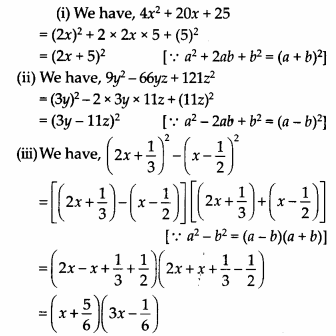
Question 27.
Factorise the following:
(i) 9x2 – 12x + 3
(ii) 9x2 – 12x + 4
Solution:
(i) We have, 9x2 – 12x + 3 = 3(3x2 – 4x + 1)
= 3(3x2 – 3x – x + 1)
= 3[3x(x – 1) – 1(x – 1)] = 3(3x – 1)(x – 1)
(ii) We have, 9x2 – 12x + 4
= (3x)2 – 2 × 3x × 2 + (2)2
= (3x – 2)2 [∴ a2 – 2ab + b2 = (a – b)²]
= (3x – 2) (3x – 2)
Question 28.
Expand the following:
(i) (4o – b + 2c)2
(ii) (3o-5b-c)2
(ii) (-x + 2y – 3z)2
Solution:
We know that
(x + y + z)2 = x2 + y2 + z2 + 2xy + 2yz + 2zx
(i) We have, (4a – b + 2c)2 = (4a)2 + (-b)2 + (2c)2 + 2(4a)(-b) + 2(-b)(2c) + 2(2c)(4a)
= 16a2 + b2 + 4c2 – 8ab – 4bc + 16ac
(ii)We have, (3a – 5b – cf = (3a)2 + (-5b² + (- c²) + 2(3a)(-5b) + 2(-5b)(-c) + 2(-c)(3a)
= 9a2 + 25b2 + c2 – 30ab + 10bc – 6ac
(iii) We have, (- x + 2y – 3z)2 = (- x)2 + (2y)2 + (-3z)2 + 2(-x)(2y) + 2(2y)(- 3z) + 2(- 3z)(- x)
= x2 + 4y2 + 9z2 – 4xy – 12yz + 6xz
Question 29.
Factorise the following:
(i) 9x2 + 4y2+16z2+12xy-16yz-24xz
(ii) 25x2 + 16y2 + 4Z2 – 40xy +16yz – 20xz
(iii) 16x2 + 4)^ + 9z2-^ 6xy – 12yz + 24xz
Solution:
(i) We have,
9x2 + 4y2 + 16z2 + 12xy – 16yz – 24xz
= (3x)2 + (2y)2 + (-4z)2 + 2(3x)(2y) + 2(2y)(-4z) + 2(-4z)(3x)
= (3x + 2y – 4z)2
[∴ a2 + b2 + c2 + 2ab + 2bc + 2ca = (a + b + c)2]
= (3x + 2y- 4z) (3x + 2y – 4z)
(ii)We have, 25X2 + 16y2 + 4z2 – 40xy + 16yz – 20xz
=(-5x)2 + (4y)2 + (2z)2 + 2(-5x)(4y) + 2(4y)(2z) + 2(2z)(-5x)
= (- 5x + 4y + 2z)2
[∴ a2 + b2 + c2 + 2ab + 2bc + 2ca = (a + b + c)2]
= (- 5x + 4y + 2z)(- 5x + 4y + 2z)
(iii) We have, 16x2 + 4y2 + 9z2 – 16xy – 12yz + 24xz
= (4x)2 + (- 2y)2 + (3z)2 + 2(4x)(-2y) + 2(-2y)(3z) + 2(3z)(4x)
= (4x – 2y + 3z)2
[∴ a2 + b2 + c2 + 2ab + 2bc + 2ca = (a + b + c)2]
= (4x – 2y + 3z)(4x -2y + 3z)
Question 30.
lf a+b+c=9 and ab + bc + ca = 26, find a2 + b2 + c2.
Solution:
We have, a + b + c = 9
⇒ (a + b + c)2 = (9)2 [Squaring on both sides]
⇒ a2 + b2 + c2 + 2ab + 2bc + 2ca = 81
⇒ a2 + b2 + c2 + 2 (ab + bc + ca) = 81
⇒ a2 + b2 + c2 + 2(26) = 81 [∴ ab + bc + ca = 26]
⇒ a2 + b2 + c2 = 81 – 52 = 29
Question 31.
Expand the following
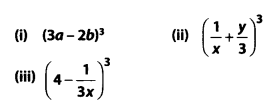 37
37
Solution:
(i) We have, (3a – 2b)3
= (3a)3 – (2b)3 – 3(3a)(2b)(3a – 2b)
[∴ (a – b)3 = a3 – b3 – 3ab(a – b)]
= 27a3 – 8b3 – 18ab(3a – 2b)
= 27a3 – 8b3 – 54a2b + 36ab2
= 27a3 – 54a2b + 36ab2 – 8b3
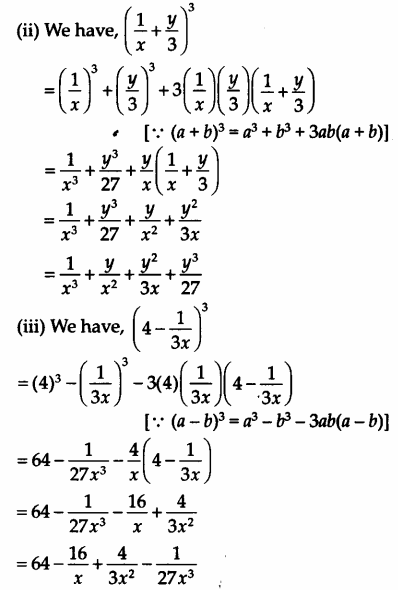
Question 32.
Factorise the following:

Solution:
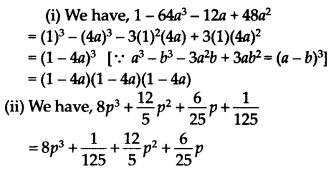
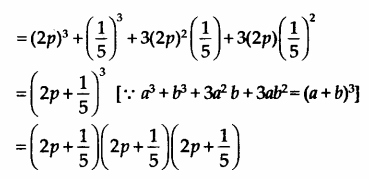
Question 33.
Find the following products:

Solution:
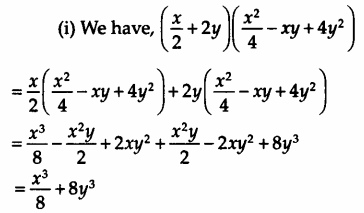
(ii) We have, (x2 – 1) (x4 + x2 + 1)
= x2 (x4 + x2 + 1) – 1(x4 + x2 + 1)
= x6 + x4 + x2 – x4 – x2 – 1 = x6 – 1
Question 34.
Factorise:
(i) 1 + 64x3
(ii) a3 – 2√2b3
Solution:
(i) We have, 1 + 64x3 = (1)3 + (4x)3
= (1 + 4x)[(1)2 – (1)(4x) + (4x)2]
[∴ a3 + b3 = (a + b)(a2 – ab + b2)]
= (1 + 4x)(1 – 4x + 16x2)
(ii) We have, a3 – 2√2b3 = (a)3 – (√2b)3
= (a – √2b)[a2 + a( √2b) + (√2b)2]
[∴ a3 – b3 = (a – b)(a2 + ab + b2)]
= (a – √2b)(a2 + √2ab + 2b2)
Question 35.
Fi nd (2x – y + 3z) (4x2 + y2 + 9z2 + 2xy + 3yz – 6xz).
Solution:
We have, (2x – y + 3z) (4x2 + y2 + 9z2 + 2xy + 3yz – 6xz)
= 2x(4x2 + y2 + 9z2 + 2xy + 3yz – 6xz) – y(4x2 + y2 + 9z2 + 2xy + 3yz – 6xz) + 3z(4x2 + y2 + 9z2 + 2xy + 3yz – 6xz)
= 8x³ + 2xy2 + 18xz2 + 4x2y + 6xyz – 12x2z – 4x2y – y3 – 9yz2 – 2xy2 – 3y2z + 6xyz + 12x2z + 3y2z + 27z3 + 6xyz + 9yz2 – 18xz2
= 8X3 – y3 + 27z3 + 18xyz
Question 36.
Factorise
(i) a3 -8b3 -64c3 -2Aabc
(ii) 2√2a3 +8b3 -27c3 +18√2abc
Solution:
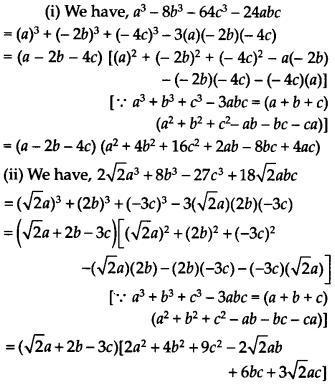
Question 37.
Without actually calculating the cubes, find the value

Solution:
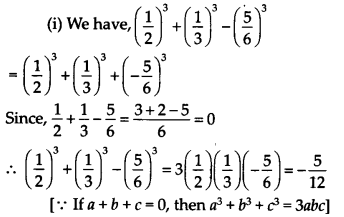
(ii) We have, (0.2)3 – (0.3)3 + (0.1)3
= (0.2)3 + (- 0.3)3 + (0.1)3
Since, 0.2 – 0.3 + 0.1 = 0,
∴ (0.2)³ + (-0.3)³ + (0.1)3 = 3(0.2) (-0.3) (0.1)
[ ∴ If a + b + c = 0, then a3 + b3 + c3 = 3abc] = -0.018
Question 38.
Without finding the cubes, factorise (x- 2y)3 + (2y – 3z)3 + (3z – x)3.
Solution:
we see that (x – 2y) +(2y – 3z)+ (3z – x) = 0
Therefore, (x – 2y)³ + (2y – 3z)³ + (3z – x)³ = 3(x – 2y)(2y – 3z)(3z – x).
If a + b + c = 0, then a3 + b3 + c3 = 3abc
Question 39.
Find the value of
(i) x3 + y3 – 12xy + 64,when x + y = -4.
(ii) x3 – 8y3 – 36xy-216,when x = 2y + 6.
Solution:
(i) Since, x + y + 4 = 0, then
x3 + y3 + (4)3 = 3xy(4)
[∴ If a + b + c = 0, then a3 + b3 + c3 = 3abc]
⇒ x3 + y3 + 64 = 12xy
⇒ x3 + y3 – 12xy + 64 = 0
(ii) Since, x – 2y – 6 = 0, then
x³ + (-2y)3 + (-6)3 = 3x(-2y)(-6)
[∴ If a + b + c = 0, then a3 + b3 + c3 3abc]
⇒ x3 – 8y3 – 216 = 36xy
⇒ x3 – 8y3 – 36xy – 216 = 0
Question 40.
Give possible expression for the length and breadth of the rectangle whose area is given by 4a2 + 4a – 3.
Solution:
Given, area of rectangle = (Length) × (Breadth)
= 4a2 + 4a – 3
= 4a2 + 6a – 2a – 3
= 2a(2a + 3) -1 (2a + 3) = (2a – 1)(2a + 3)
Hence, possible length = 2a -1 and breadth = 2a + 3
Exercise 2.4
Question 1.
If the polynomials az3 + 4z2 + 3z – 4 and z3 – 4z + o leave the same remainder when divided by z – 3, find the value of a.
Solution:
Let p1(z) = az3 + 4z2 + 3z – 4 and p2(z) = z3 – 4z + o
When we divide p1(z) by z – 3, then we get the remainder p,(3).
Now, p1(3) = a(3)3 + 4(3)2 + 3(3) – 4
= 27a+ 36+ 9-4= 27a+ 41
When we divide p2(z) by z-3 then we get the remainder p2(3).
Now, p2(3) = (3)3-4(3)+a
= 27-12 + a = 15+a
According to the question, both the remainders are same.
p1(3) = p2(3)
27a + 41 = 15 + a
27a – a = 15 – 41 .
26a = 26
∴ a = -1
Question 2.
The polynomial p{x) = x4 – 2x3 + 3x2 – ax + 3a – 7 when divided by x + 1 leaves the remainder 19. Find the values of a. Also, find the remainder when p(x) is divided by x + 2.
Solution:
We have, p(x) = x4 – 2x3 + 3x2 – ox + 3a – 7
Since p(x) is divided by x + 1, then remainder is p(-1).
p(-1) = (-1)4 – 2(-1)3 + 3(-1)2 – a(-1) + 3a – 7 = 1+ 2 + 3 + o + 3a – 7 = 4a – 1
p(- 1) = 19 (Given)
⇒ 4a – 1 = 19 ⇒ 4a = 20
∴ a = 5
Thus, required polynomial,
p(x) = x4 – 2x3 + 3x2 – 5x + 3(5) – 7
= x4 – 2x3 + 3x2 – 5x + 8
Now, this is divided by x + 2, then remainder is p(-2).
p(- 2) = (- 2)4 – 2(- 2)3 + 3(- 2)2 – 5(- 2) + 8
= 16 + 16 + 12 + 10 + 8 = 62
Question 3.
If both x – 2 and x -(1/2) are factors of px2+ 5x+r, then show that p = r.
Solution:

Question 4.
Without actual division, prove that
2x4 – Sx3 + 2x2 – x + 2 is divisible by x2 – 3x + 2. [Hint: Factorise x2 – 3x + 2]
Solution:
Let p(x) = 2x4 – 5x3 + 2x2 – x + 2
Now, x2-3x + 2 = x2 – 2x – x + 2
= (x-2)(x- 1)
Hence, zeroes of x2 – 3x + 2 are 1 and 2.
⇒ p(x) is divisible by x2 – 3x + 2 i.e., divisible by x – 1 and x – 2, if p(1) = 0 and p(2) = 0
Now, p(1) = 2(1)4 – 5(1)3 + 2(1)2 -1 + 2
= 2 – 5 + 2 – 1 + 2 = 6 – 6 = 0
and p( 2) = 2(2)4 – 5(2)3 + 2(2)2 -2 + 2
= 32 – 40 + 8 = 40 – 40 = 0
Hence, p(x) is divisible by x2 – 3x + 2.
Question 5.
Simplify (2x- 5y)3 – (2x+ 5y)3.
Solution:
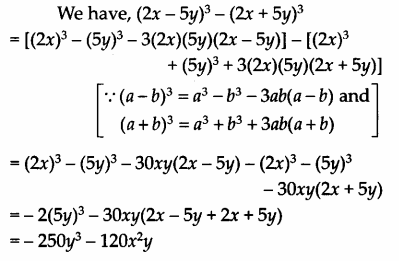
Question 6.
Multiply x2 + 4y2 + z2 + 2xy + xz – 2yz by (-z + x-2y).
Solution:
We have,
(x2 + 4y2 + z2 + 2xy + xz – 2yz)(- z + x – 2y)
= x2 (- z + x – 2y) + 4y2(- z + x – 2y) + z2(- z + x – 2y) + 2xy(- z + x – 2y) + xz(- z + x – 2y) – 2yz (- z + x – 2y)
= -x2z + x3 – 2 x2y – 4y2z + 4xy2 – 81y3 – z3 + xz2 – 2yz2– 2xyz + 2x2y – 4xy2 – xz2 + x2z – 2xyz + 2yz2 – 2xyz + 4y2z
= x3 – 8y3 – z3 – 6xyz
Question 7.

Solution:
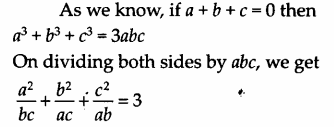
Question 8.
If a + b + c = 5 and ab + bc + ca = 10, then prove that a3 + b3 + c3 – 3abc = -25.
Solution:
We have, a + b + c = 5,ab + bc + ca = 10
Since (a + b + c)2 = a2 + b2 + c2 + 2(ab + bc + ca),
then (5)2 = a2 + b2+ c2 + 2(10)
⇒ a2 + b2 + c2 = 25 – 20
⇒ a2 + b2 + c2 = 5 … (i)
L.H.S. = a3 + b3 + c3 – 3abc
= (a + b + c)(a2 + b2 + c2 – ab – be – ca)
= (5) [5 – (ab + be + ca)] [From (i)]
= 5(5 -10) = 5(-5) = – 25 = R.H.S.
Question 9.
Prove that (a +b +c)3 -a3 -b3 – c3 =3(a +b)(b +c)(c +a).
Solution:
L.H.S. = [(a + b + c)3 – a3] – (b3+ c3)
= (a + b + c – a)[(a + b + c)2 + a2 + (a + b + c)a] – [(b + c) (b2 + c2– be)]
x3 – y3 = (x – y)(x2 + y2 + xy) and
x3 + y3 = (x + y)(x2 + y2 – xy)
= (b + c)[a2+ b2+ c2 + 2 ab + 2 bc + 2 ca + a2+ a2 + ab + ac] – (b + c)(b2 + c2 – bc)
= (b + c)[3a2+3ab + 3ac + 3bc]
= (b + c)[3(a2+ ab + ac + bc)]
= 3 (b + c)[a(a + b) + c(a + b)]
= 3(a + b)(b + c)(c + a) = R.H.S.
We hope the NCERT Exemplar Class 9 Maths Chapter 2 Polynomials will help you. If you have any query regarding NCERT Exemplar Class 9 Maths Solutions Chapter 2 Polynomials, drop a comment below and we will get back to you at the earliest